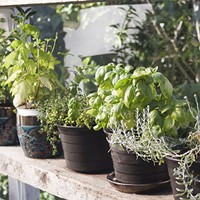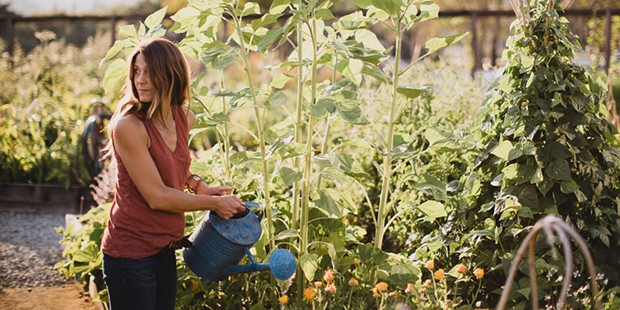Copy Nature and Grow a Thriving Kitchen Garden
Planting, fertilizing and controlling pests, wild style
By Emily Murphy[
{
"name": "Top Stories Video Pair",
"insertPoint": "7",
"component": "17087298",
"parentWrapperClass": "fdn-ads-inline-content-block",
"requiredCountToDisplay": "1"
}
]
The secret to growing a thriving kitchen garden is to follow nature. A quick look at any healthy, living system reveals a clamor of diversity: plants of different kinds keeping company while a mix of good bugs and bad ones busy themselves with the routine of daily living. You'll also find a variety of birds and most likely a host of creatures you don't recognize — but they're part of the puzzle, too.
When a garden is designed as a slice of life, the rewards are greater than a colander of snap peas or a bumper crop of tomatoes. Your garden is your most immediate touchpoint with nature, a welcoming place to play and contemplate, and when you look to companion plants such as edible flowers and herbs to build diversity, you now have a greater variety of robust and aromatic ingredients to savor from garden to table.
Companion Planting with Edible Flowers and Herbs
Here in coastal Northern California, we're fortunate to have a mild and inviting climate for growing most anything. Except for summer fog, there are few limitations. It's cool enough in winter to sweeten cold-loving vegetables like brassicas and warm enough in summer to yield a bumper crop. Throwing a handful of your most loved herbs and edible flowers into the mix serves as an added level of protection for your garden, confusing pests that target host plants by smell with a myriad of scents, while inviting pollinators. Plus, you get flowers.
I love a neat row of veggies as much as the next person but to see a garden spilling over with color and a mix of textures and blooms is truly remarkable and not so difficult to achieve. You simply need to let go of perfection and embrace chaos — even a little bit of chaos will do.
Next, consider the plants you love most and start with these. What are the flavors you crave and the ingredients you find yourself reaching for each day? Perhaps it's cilantro, 'Mrs. Burns' basil, lemon thyme, or pineapple mint? Or maybe it's the soft, tangerine-hued petals of calendula in your evening salad? Begin with a handful of plants and devise a basic plan.
Grow sun loving edibles, such as thyme and nasturtiums, along the south side of beds, and place herbs like cilantro and parsley in between plants or on the north side of taller fruits and vegetables where they benefit from a little shade in summer months. I always grow basil near tomatoes because I've found basil improves the flavor of tomatoes. And there's always room for a sunflower or two near green beans or planted among summer squash, cucumbers and even sugar baby melons. The large, heart-shaped leaves of squash act as ground cover, protecting soil moisture while making it more difficult for weeds to take hold. If you're growing mint, keep it close to other plantings but be sure to give it a container of its own or it will happily take over your garden.
Garden Organically
There's no need to add chemicals or synthetic fertilizers to your kitchen garden when companion planting. Instead, let the plants do much of the work for you. I've found that the more diverse a kitchen garden, the less likely you are to battle an invasion of pests such as aphids or cabbage worms. Avoid planting large patches of any one variety and tuck plants like violas, oregano and chervil into corners and between edibles like leafy greens and alpine strawberries.
Pesticides and chemical fertilizers are indiscriminate, poisoning good bugs and bad bugs alike, while breaking the cycle of natural systems living above and below the soil. Support diversity by feeding your garden, however big or small, with healthy soil practices.
Build Soil Naturally
Soil is alive. It's the heart of the garden, and the better your soil the better your food will taste and the more likely your garden will thrive. To build soil naturally, simply copy nature.
In nature, trees drop leaf litter and plants live and die, leaving organic materials behind such as roots, stems and leaves. Bacteria and other soil life work away eating and pooping, decomposing what plants have provided. The process creates rich, healthy soil for future successional plantings. When we do our best to replicate this system, providing a home for a flourishing soil ecosystem, it naturally supports a flourishing garden.
Begin any garden with a fairly even mix of organic soil and compost. Once you're off and growing, apply a healthy layer of compost in the spring and again in the fall, and mulch liberally with most crops sourcing mulch materials locally whenever possible. Rice straw is good and leaves from your yard are even better. (Though be careful to avoid using leaves of plants that are allopathic, or medicinal, such as eucalyptus.) Look to natural sources of amendments, such as worm castings, or make your own manure or comfrey tea when plants need a boost of nitrogen.
Grow What You Love
Organic practices and cultivating healthy soil are enough for most any garden to thrive, especially when you take a simple, systematic approach, copy nature as best as you can and check on your garden often. Growing a handful of beneficial plants — especially ones that double as edible wonders, like herbs and flowers — and taking a quick stroll with your morning tea to keep an eye on things is all you need to grow what you love.
Emily Murphy was raised in Arcata and is the author of Grow What You Love, a foodie gardening book featuring 12 sets of seasonal ingredients to change the way you cook and live. Discover a full directory of edible flowers, herbs, and more in her book. Find it wherever books are sold.
Are you a writer who likes to get your hands dirty? The Journal is looking for garden writers. Email [email protected].
Speaking of Organic Gardening, Kitchen Garden
-

Micro-farming a Kitchen Herb or Succulent Garden
Aug 29, 2019 - More »

































